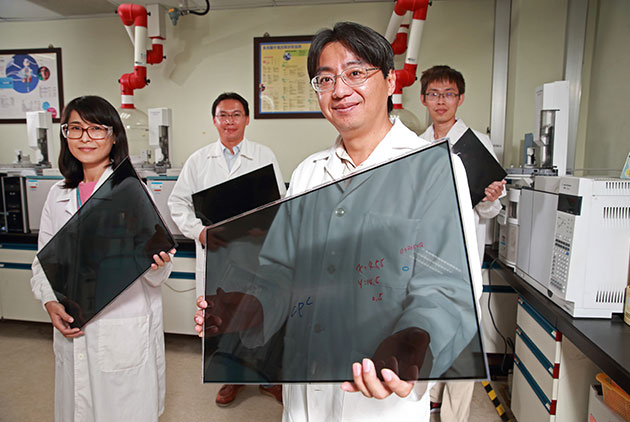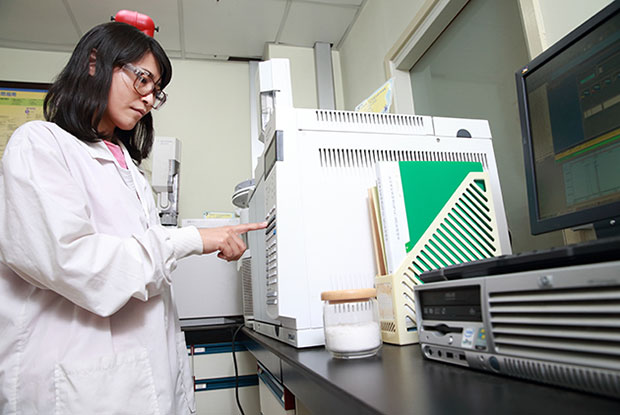Saving Panel Makers Billions
ITRI’s Liquid Crystal Recycling Breakthrough

Source:Chien-Tong Wang
Taiwanese LCD display makers generate large volumes of scrap screens that have been buried in landfills or crushed into pellets for use in construction. But Taiwan’s ITRI has stunned the world by finding a way to bring discarded panels back to life.
Views
ITRI’s Liquid Crystal Recycling Breakthrough
By Laura Kangweb only
“Global liquid crystal suppliers are all really wondering how Taiwan is able to recycle liquid crystals.”
That’s how Sung Hsin-chen, the deputy executive director of the Environmental Protection Administration’s Recycling Fund Management Board, described the world’s reaction to a recycling breakthrough that could change how LCD (liquid-crystal display) panels are made.
Liquid crystal materials have been around for over a century. Big multinationals such as Germany-based Merck Group are now the main producers of liquid crystals and the biggest source of imported raw materials for Taiwan’s LCD manufacturers. But the ability to recycle liquid crystals from discarded flat panels has so far eluded these prominent global suppliers.
It was not until last year that the answer to the riddle finally surfaced in the form of an “LCD Waste Recycling System” developed by the government-backed Industrial Technology Research Institute. It was cast in the spotlight by winning an R&D 100 Award, known as the “Oscars of Innovation.”
The system extracts liquid crystals from discarded panels for reuse in the production process, which can save a panel manufacturer more than NT$1 billion in new raw material costs a year.
The nearly 100 percent recovery of the liquid crystals also transforms the panel’s glass substrate into a new usable material, easing the burden on landfills and lowering the risk of water pollution from scrap LCD screens.
Now, the complete panel, from the glass on the outside to the liquid crystals on the inside, can be recycled, which for Taiwan has increased the value and usefulness of screens that have been consigned to garbage dumps.
That’s a big deal when one considers how much electronic waste is produced. In 2016, the world generated 44.7 million metric tons of electronic waste, or about 4,500 Eiffel Towers, and only 20 percent of that was recycled through appropriate channels, according to a United Nations report.
Taiwan is the world’s third largest producer of LCD panels – a key component in many electronic products – and generates about 8,000 metric tons of waste panels a year. Beyond simply burying them, the only recycling option for them in the past, and one with limited economic value, was to crush them and use the waste glass as a building material.
“The yield rate of our [panel plants] is the highest in the world. We have very good technology. But when it came to figuring out how to handle discarded panels, we initially had no idea of how to proceed,” admits Hung Huan-yi, deputy director of ITRI’s Material and Chemical Research Laboratories.
In particular, liquid crystals have been critical to the evolution of panel technology, and Taiwan has long been dependent on imports of the material. At a price of about US$5 per gram, panel suppliers in Taiwan spend nearly NT$30 billion a year to buy the material from Merck Group and other big suppliers.
Two Birds with One Stone: Economical and Eco-friendly
The 10-person team led by Hung researched the waste recycling technology for more than 10 years to help resolve the industry’s pain points. The team’s starting point consisted of two questions: “Is there a way to recycle liquid crystals?” and “How can it be done to strengthen productivity and be environmentally friendly?
Hung recalls visiting a major flat panel producer at the time, and R&D staff took to him to a room with shelves stacked with unusable liquid crystal material that had been accumulated over many years.
“Its value alone was more than NT$2 billion,” he estimates.
Liquid crystal materials only account for around 3 percent of an LCD display’s production costs, but if they can be recycled and re-introduced into the process, it can directly reduce the amount display makers have to spend on new materials while also solving solid waste handling problems. In other words, killing two birds with one stone.
That motivated ITRI to study how to recycle and reuse scrap liquid crystal displays, but it immediately ran into problems.
“We needed at least three to five years to make breakthroughs for each type of technology required,” recalls Lu Chien-wei, a researcher in ITRI’s Material and Chemical Research Laboratories.
 The technology to extract liquid crystals from discarded panels was complicated and took ITRI 10 years to crack. (Photo: Chien-Tong Wang)
The technology to extract liquid crystals from discarded panels was complicated and took ITRI 10 years to crack. (Photo: Chien-Tong Wang)
Recycling Different Liquid Crystals a Problem
Lu says there are two main sources at present for recyclable liquid crystals – defective panels from the production line and waste electronic products, such as those with LCD screens. An LCD panel may be only a few millimeters thick, but it consists of at least 10 kinds of materials, meaning that once the panel’s two glass substrates are split apart, other materials have to be eliminated before the liquid crystals can be extracted.
That extraction technology alone took the ITRI nearly 10 years to develop.
Once the material has been extracted, the next step is “purifying” it, a challenge that even the big liquid crystal suppliers doubted could be overcome because of the variety of materials involved.
Dick Hsieh, the managing director of Merck Group Taiwan, explains that liquid crystal materials are usually customized because they are used in different combinations for panels of different specifications. To meet those requirements, Merck Group sells more than 100 types of liquid crystals, each with distinct compositions.
“So to recycle all of those materials together and then treat them so they can be reused is basically really difficult,” especially considering that the higher a screen’s resolution, the higher the purity of the liquid crystals required, Hsieh says.
To tackle this “mission impossible,” ITRI researchers resorted to distillation, adsorption and filtering to remove impurities from the extracted liquid crystals, hoping to elevate the material’s level of impurities to “parts per billion” (ppb). It set a goal for impurities not to exceed 1 ppb.
As liquid crystal formulas were changing to meet more exacting flat panel specifications, the ITRI’s purification technology had to grow even more sophisticated. By using a “repeated verification” approach, ITRI has been able to identify different types of liquid crystals and blend them together into products that meet the needs of panel manufacturers.
“That’s the reason nobody overseas has been able to do this yet,” Lu says.
Though developing a technology can be difficult, having it reach beyond the laboratory can be even more challenging. ITRI’s Hung admitted that even though the process had been developed over many years and received related patents, panel manufacturers were initially unwilling to use it.
“We had to rely on our industry contacts and ask them to give us a hand by letting us try [the technology] out,” Hung says.
Panel makers were reluctant to take the plunge because of the irreparable harm they could suffer if using the recycled liquid crystal material resulted in quality problems. To verify the technology, they also had to stop their production lines, not an appealing prospect.
“A production line’s capacity is about NT$60 million a day. Who is willing to take that risk?” Hung says.
Just to get the process into a factory on a trial basis took a year, but once one company adopted it, others were willing to follow.
One of Taiwan’s two biggest LCD display producers, Innolux Corporation, formally signed an agreement with the ITRI last year that will pave the way for the ITRI’s waste processing system to be installed in its nine factories in Tainan within two years. The necessary equipment is now being built.
By extracting and reusing liquid crystals, the technology is expected to save Innolux hundreds of millions of Taiwan dollars a year in procurement costs, and it will make the production process more eco-friendly. Recycled scrap panels will no longer contain toxic liquid crystal material that has made buried panels a pollution threat.
At present, the system can treat 1,000 metric tons of discarded LCD displays a year. The leftover waste glass can be used as a nanoporous adsorbent capable of removing heavy metals from wastewater and soil, a departure from the more traditional coagulation and sedimentation approach. The method is currently being tested in the electroplating section of the Changhua Coastal Industrial Park on a trial basis.
“This proves that we can not only recycle and reuse waste materials but also solve other people’s pollution problems, putting the concept of ‘urban mining’ into practice,” says the EPA’s Sung.
The development is favorable for flat panel makers because of the money they can save, and Merck Group’s Hsieh sees it as making perfect sense from his customers’ perspective.
“From an environmental point of view, you don’t want to waste anything. Every little bit of liquid crystal material represents a cost, so the ability to recycle it is of course beneficial to the companies,” Hsieh says.
Though the technology could cut into Merck Group’s raw material sales, Hsieh said it has not had much of an affect so far, and his company will continue to work with panel makers in creating new technologies and applications and provide products that meet their needs.
 The waste recycling system developed by the ITRI can turn the waste glass found in recycled LCD display chips into adsorbents to remove impurities from wastewater. (Photo: Chien-Tong Wang)
The waste recycling system developed by the ITRI can turn the waste glass found in recycled LCD display chips into adsorbents to remove impurities from wastewater. (Photo: Chien-Tong Wang)
Good Technology Benefiting the World
The ITRI’s technology is creating new value for discarded screens once treated as garbage, giving it value even in places where LCD displays are not widely manufactured. The ITRI has started to export its technology to the United States to help companies there extract liquid crystals from used panels and enable the waste glass to have more uses, hoping that this more environmentally friendly approach can solve a growing electronics waste problem.
“Although the direct beneficiaries seem to be Taiwanese flat panel makers, in the bigger picture, human beings and the environment are also beneficiaries because a source of waste and pollution has been reduced,” Hung says.
In an age of increasingly sophisticated electronic products and shorter product life cycles, finding better ways to recycle and reuse materials has become a pressing issue around the world, and Taiwan, as a big producer of LCD displays and semiconductors, is no exception.
The growing volume of smart devices permeating daily life will create even greater amounts of waste in the future, and if Taiwan can find ways to break through technology barriers and develop viable recycling systems, it will inevitably emerge as a good business and good optics for the country.
Developer: Material and Chemical Research Laboratories, Industrial Technology Research Institute
Factories Using It: Innolux Corporation and others
Technology Used: Extracting liquid crystals from discarded flat panel displays and recycling and reusing them in the production process, saving costs
Impact: Recycling 1,000 metric tons of discarded panels a year will help panel makers save more than NT$1 billion on purchases of new liquid crystal material.
Translated from the Chinese Article by Luke Sabatier
Edited by Shawn Chou
Additional Reading
♦ Is Taiwan Ready for the Circular Economy?
♦ Spinning Waste into New Tires Raises Global Interest
♦ Embracing the Circular Economy: Don’t Call Me ‘Garbage’







